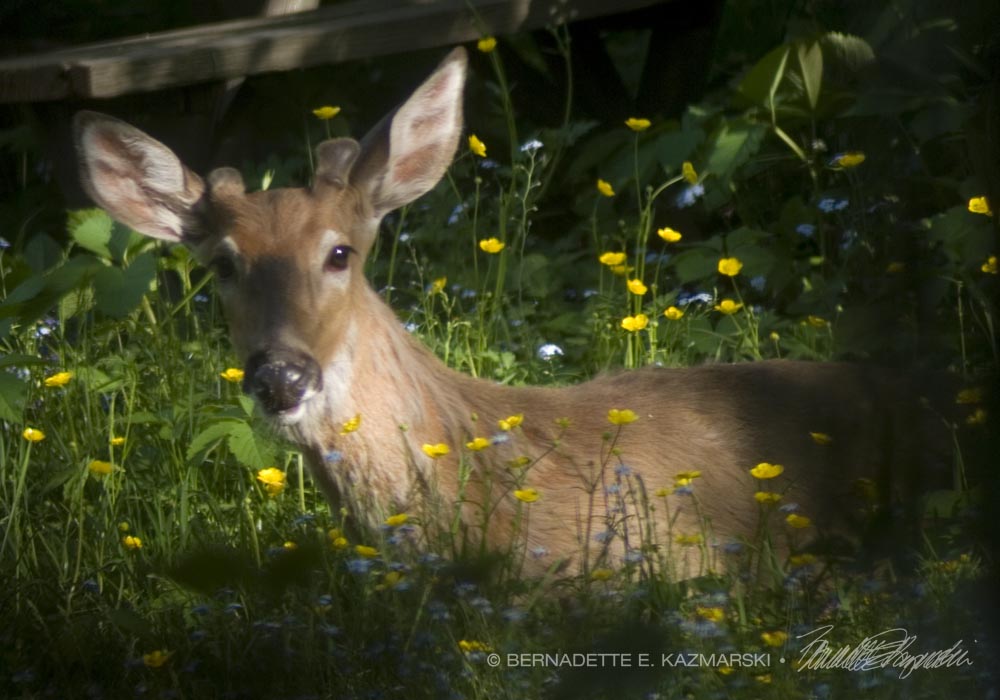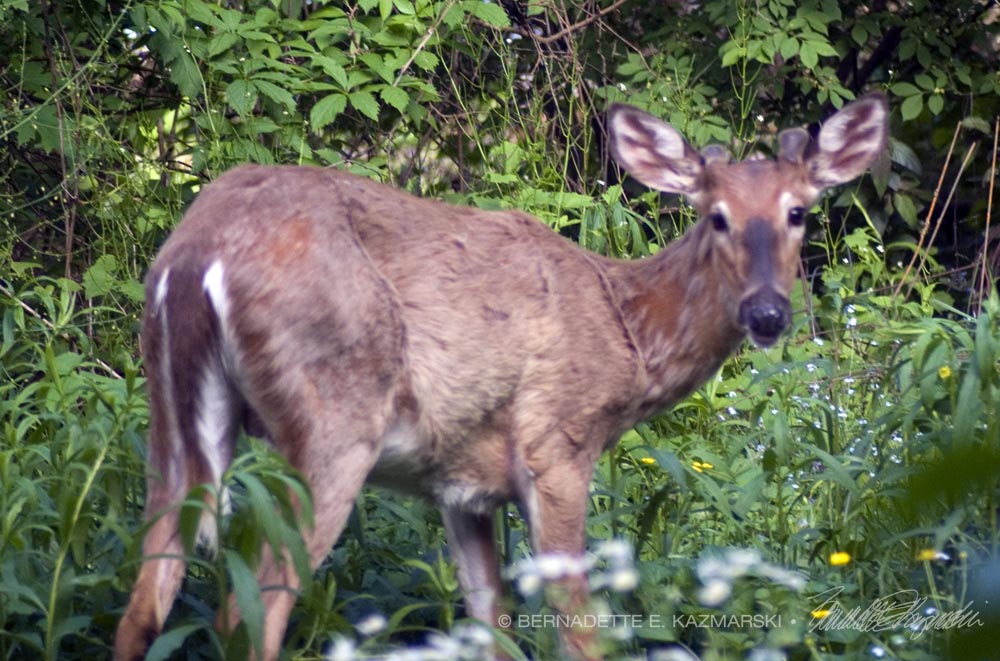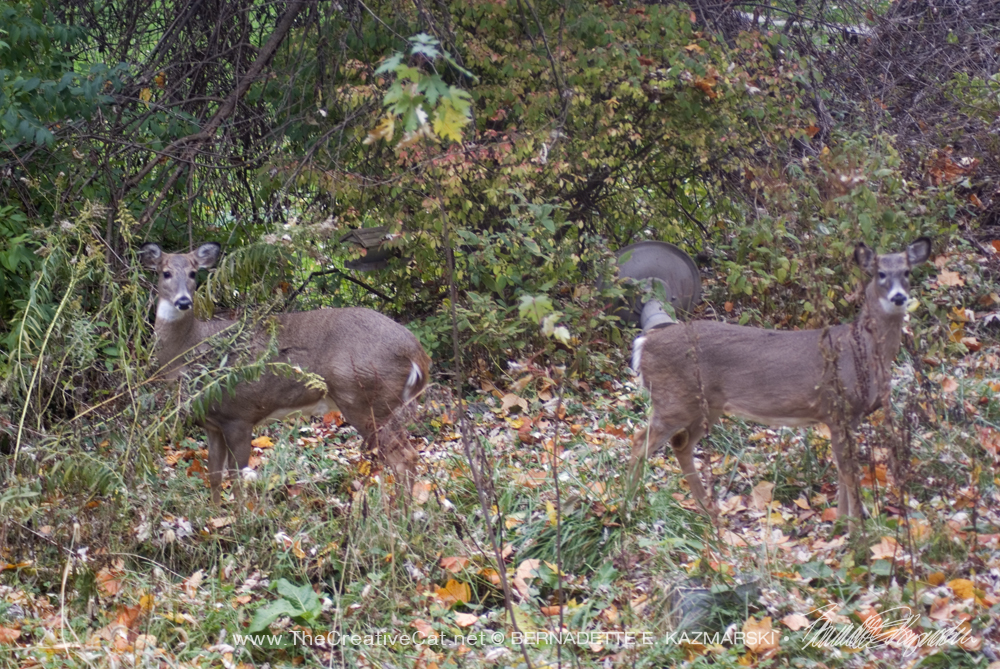Animals In Our Midst

Last May I looked out my window to see the scene above in my back yard. I think the buck felt he’d entered Nirvana and laid down to consider the implications of that, and stayed quite a while.
Small, but full of native wildflowers and a petite meadow in the center, it’s surrounded by both young and mature trees and some berries and shrubs, as well as other tasty plants all laid out in shapes with convenient paths for grazing, and no smell of chemicals at all. Yes, many other animals have found my little backyard wildlife habitat to be a Nirvana, and for the first time in the 25 years I’ve lived here and developed this little habitat a white-tailed deer came to visit.
I knew why it took that long for the deer to show up here. White-tailed deer are ubiquitous in my state, Pennsylvania, and fairly flexible in their habitat and diet. When their typical forest habitat is not available they’ve simply moved in with people. My little town is a small community mostly developed for over a century in tight older neighborhoods interspersed with parks and hillsides that can’t be developed, and hilltops surrounding that were left wooded. In the past 20 years, much of that undeveloped land has been developed. About five years ago the last available hilltop land in our community was cleared for yet another housing development and the deer on my side of town, now with no contiguous habitat, walk down the streets from the top of the hill to the few wooded areas at the bottom, not just in my back yard, but in the wooded area that fills between our back yards where the hill was too steep to build the planned street a century ago.
I thought it was magical, even when his appearance with a lady friend and possibly a daughter essentially ended my gardening season for last year.

I love my flowers, many of which are volunteer native plants loving the extra care from a lightly tended site. Others are plants moved from my mother’s yard through the years and just when I’d sold her house and dug up the last few, still others given to me by elderly neighbors long since gone, or simply by friends and neighbors in plant swaps.
Vegetable gardening is not something I grew up doing, a lifelong habit, a fun thing to pass the time on summer mornings, something to talk about with other gardeners. My garden is and has always been a subsistence garden for me, from finding seeds for native and heritage vegetables, saving my seeds from year to year and adding a few extras now and then, carefully planning what I’d grow, when I’d plant and harvest, starting plants myself and harvesting and preserving all that I grew, gardening from early March to December with season extending cold frames and using the “time off” to start the next year’s garden. All things are grown in the compost from my own kitchen scraps mixed with garden trimmings and autumn leaves and shredded cotton drawing paper and matboard from my studio. Many years all my vegetables came from my own soil, grown with no chemicals, carefully watered with no waste, of water or of money.
Because I could never afford to buy vegetables of the quality I can grow in the quantity I need them. My garden has kept me through good times and seen me through some pretty slim times, and given me health, inspiration and contemplation as well.
So when the buck showed up in my back yard in May, I knew it was going to change a few things. He and his little family had already seen a huge amount of change in their habitat and adjusted. I needed to adjust mine as well.
Did I want him dead? I can get pretty mad when I’m feeling protective about seedlings I’ve started from rare seeds, flowers that bear memories, and worrying about putting food on the table and preserving for winter, the groundhog and the rabbits can tell you all about that. I might yell all about turning someone into pot roast or cat food, but they and I know it’s all talk. They ignore me and I get over it and just add some sort of a barrier that either repels them so that I preserve enough for me or keeps them out of an area completely.
I had no time or means at that point last year to erect a fence, so I protected what I could and let the rest go. I’m planning this year’s garden and I’ll be starting a little later so that I can get minor construction completed after the ground can be worked enough to build a fence to keep them out of the vegetables. I’ll see what happens with the rest.

What precipitates all this discussion of deer and me and my garden? A local deer “cull” and the presence of white-tailed deer in our communities, and the concept of slaughtering animals who get in our way.
I know that deer are involved in accidents on our roadways by running to cross a road. Killing them down to a certain presumed population is really not going to stop that as even just a few deer in the area are still likely to run out into a road at a moment when a vehicle is unable to stop. Deer are hit all the time on back roads and highways in rural areas where they are not so crowded for space and hunting is permitted, so reducing their numbers as a public safety move makes little sense. People who drive in areas where deer are even more numerous are accustomed to watching for deer along the road and observing their behavior to avoid these accidents. We all need to do this.
I also know that deer eat plenty of things, and even things more important than our garden plants. Because much of what is left to them as habitat is our undevelopable steepest slopes, they make the best use of what’s there, agile enough to climb and graze. But the brush and young trees are often what’s holding the soil in place and clearing a steep slope can be a factor leading to one of our famous landslides.
And not only on steep slopes but deer can clear any wooded area of the brush and other plants growing there, depriving other forest species of habitat in turn. Species of songbirds such as thrushes nest only in the dense shrubs that fill the understory, the wood thrush, veery and our good old friend the American Robin among them.
You can be sure they don’t nibble around endangered plant species either. In 1948 a local resident purchased land along Squaw Run Road in Fox Chapel intending to conserve that unique site, calling it the “Trillium Trial”, in 1950 it was honored with the highest award given by the National Council of State Garden Clubs, and since then it has been a destination each spring as this species of native white flowers, protected and imperiled in some areas, covered the slopes in early May each year. White-tailed deer found it in the early 90s and nearly overnight grazed it to the ground, this happening every spring for several years until the colony of trillium could barely survive. This community erected a fence to keep the deer out of this area and the trillium colony is recovering.
It’s part of the nature of life on earth to recycle what is made, and that includes the predator and prey relationship of living things. At one time big cat species and wolves predated on white-tailed deer, as did humans, both until relatively recently. Now, for our own safety we’ve removed all their predators, other than ourselves, and even including ourselves because though there are many who still hunt there are not nearly as many as there once were when venison provided much of the meat for humans and deer hides clothed them. Despite the fact that we seem to be developing every square inch of land whenever possible today, only decades ago Allegheny County was once covered with farmland, even if it fell out of use in the last century, and there was plenty of habitat. Deer evolved to reproduce enough to carry on their own species in the face of all the predators, now suddenly with all their predators removed they are still reproducing at the same rate, while losing their habitat, and they also come to suffer starvation and increased illness from overpopulation.
Deer don’t move well. Easily frightened and their long slender legs easily injured, herding them up or packing them into trucks to go and live in the Allegheny Forest is not an option, so deer populations have to be somehow controlled right where they are. Cornell University, with several huge populations on campus, tried a program with their veterinary school of sterilizing and tagging deer, and though it was said they would not survive the handling and surgery they lost only four. But deer live a long time and though they did not reproduce the populations did not decrease and deer still suffered from overcrowding and they now use in integrated approach. Other communities around the country have tried various types of chemical or hormonal birth control with various successes, but because of the way these are usually distributed—by food bait, not by direct application to the animals—it’s considered dangerous to use in populated areas where pets or people could come in contact with it. Still other communities have called up on the skills of their local hunters with compound bows and rifles to hunt the deer as safely as possible each year so populations don’t increase. A report from the University of Missouri Extension outlines an integrated program that involves many human efforts and also relies on the skill of licensed hunters.
Mt. Lebanon had at one time used this last method, but apparently stopped a few years ago. The deer did not stop reproducing, nor did development stop in their community or the surrounding communities. They have had complaints about accidents between cars and deer and of course landscaping. But the solution they’ve found to cull their herd by about 150 deer during this month sounds like a form of torture or sick entertainment that’s been used elsewhere but never used yet in Pennsylvania. They plan to set up 8’ x 8’ fenced traps and lure the deer into them with automatic feeders, and as soon as there are deer in the trap the gate will close by remote control and sharpshooters will arrive to use silenced rifles to “euthanize” them by shooting them from close range.
I’m trying to picture a bunch of deer standing calmly by when the gate closes behind them, and remaining calm until the sharpshooters arrive and take aim and give them one quick killing shot in the head. Rather, multiple terrified deer trapped inside of an 8’ x 8’ pen trying to make their way to safety is horrible enough to visualize as they would leap and tangle their legs in the fencing, land on top of each other, injure themselves and each other and still struggle for freedom. Then one or more humans would arrive with all their scents of humans, vehicles and guns, aim at them and shoot them—or shoot at them because those deer would certainly be panicked even more that they are not going to stand still and wait for their merciful shot in the head, panicking even more when they are shot and not killed but painfully injured. They plan to kill 150 deer this way.
It’s illegal in the state of Pennsylvania for a hunter to bait an animal during hunting, and shooting animals in a trap goes against what hunters and many others see as a fair contest. And the commissioners chose areas to place the traps without checking for safety—one of them within 1,000 feet of a school which violates federal gun laws prohibiting the discharge of a firearm that close to a school. Another park is technically on another township’s property and they flatly said it could not be done on their property. Another is near a major road with gas and electrical lines near. The community is pretty tightly populated and just about all the sites they chose can be seen from the windows of a house or school or public place, so at any given time, even in the dark, people would be witness to this, possibly children or anyone with a soul.
They are paying $500 per deer to do this. And the surviving deer will begin reproducing once again. The community seems to support it, though support is waning. But if they felt the deer were an issue years ago and used sharpshooters to reduce numbers why did they stop and let it get out of control? If they feel the need to suddenly catch up can they only find this horribly inhumane way to do it? Are the deer really that bad that they need to be immediately killed?
But if it’s not white-tailed deer it’s other animals, or animal smells from farms, or some other part of nature that gets in the way of peoples’ lives and development and there seems to be no time or interest in finding a real solution, much less considering a little inconvenience to our lifestyles as part of it, or having humans take responsibility for their part in it, like not killing homeless cats but instead enforcing laws requiring people to be responsible for their pets and have them spayed or neutered. It’s said that humans and cockroaches are the two most adaptable species on earth. When are we going to realize we share this earth and use that adaptability we have to leave a reasonable measure for other species instead of killing them off when they get in the way?
Read more Essays on The Creative Cat.
All images used on this site are copyrighted to Bernadette E. Kazmarski unless otherwise noted and may not be used without my written permission. Please ask if you are interested in using one in a print or internet publication. If you are interested in purchasing a print of this image or a product including this image, check my Etsy shop or Fine Art America profile to see if I have it available already. If you don’t find it there, visit Ordering Custom Artwork for more information on a custom greeting card, print or other item.
Subscribe to The Creative Cat on your Kindle

Start with a 14-day free trial. You can cancel at any time during the free trial period. If you enjoy your subscription, do nothing and it will automatically continue at the regular monthly price of 99 cents. Click here to subscribe to The Creative Cat on your Kindle.


